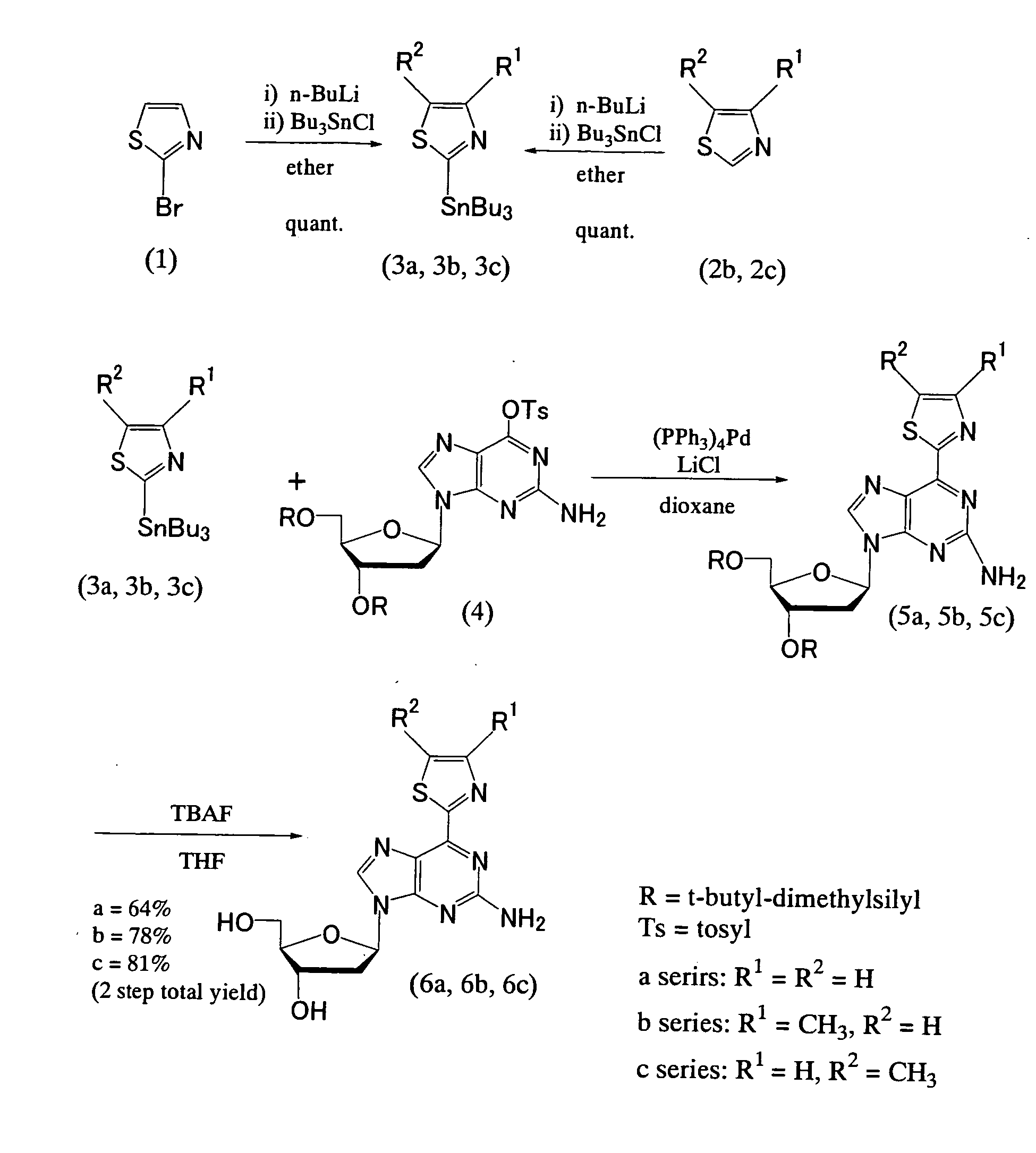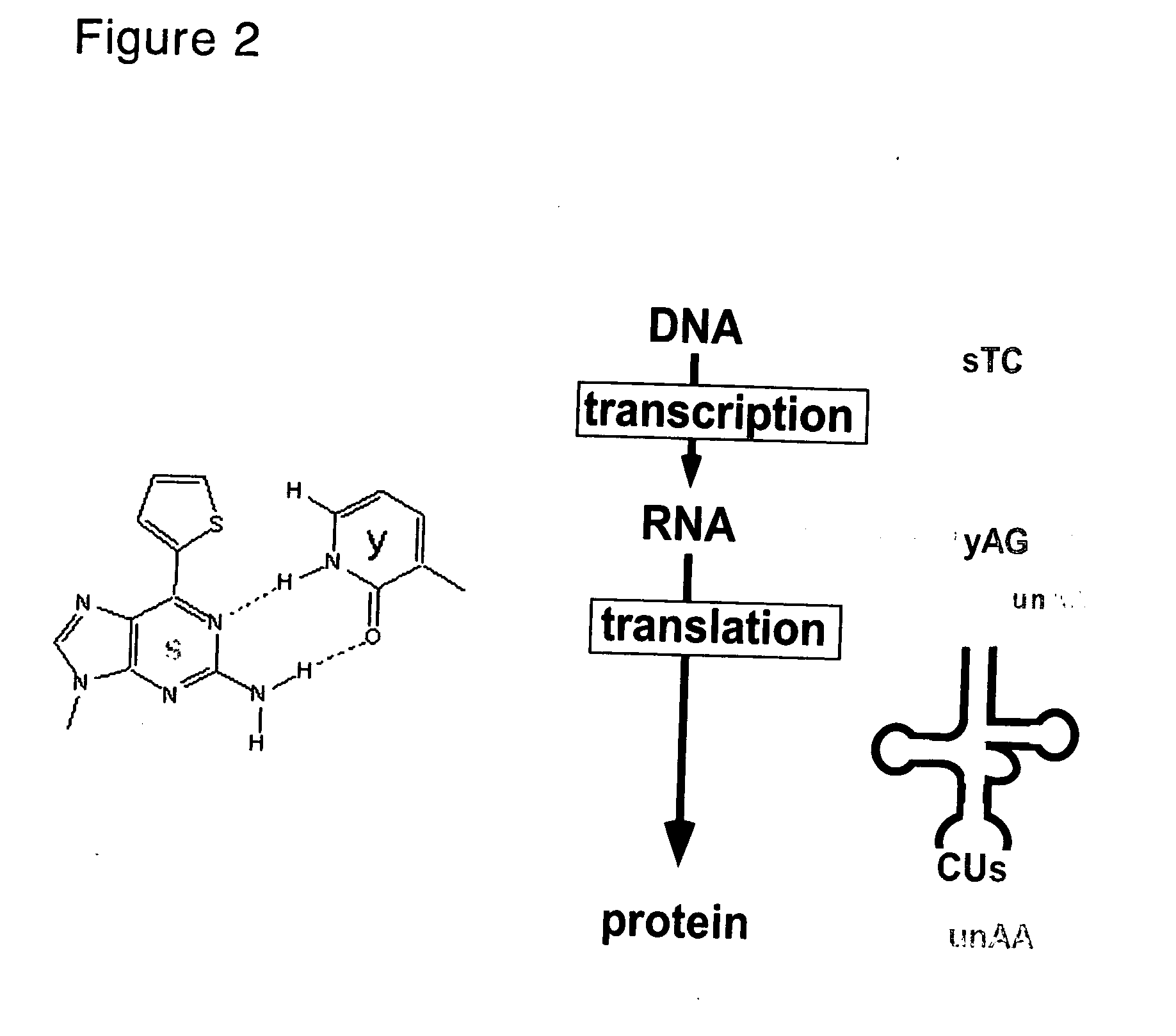Nucleoside and nucleotide having an unnatural base and use thereof
a technology of nucleosides and nucleotides, applied in the field of nucleosides or nucleotides having unnatural bases, can solve the problems of difficult amplifaction of nucleic acids thus obtained, limited chemical and physical diversity of nucleic acids, and difficulty in synthesizing long-chain nucleic acids
- Summary
- Abstract
- Description
- Claims
- Application Information
AI Technical Summary
Benefits of technology
Problems solved by technology
Method used
Image
Examples
example 1
Synthesis of a 2-amino-6-(2-thiazolyl)-9-(2-deoxy-(β-D-ribofuranosyl)purine derivative (FIGS. 5-7)
1) Synthesis of 2-tributyltin thiazole (Compound 3a) (FIG. 5)
[0103]Under an argon atmosphere, n-butyllithium (1.57 M in hexane, 3.2 ml, 5.0 mmol) was added to diethyl ether (25 ml) which had been cooled to −78° C. Subsequently, 2-bromothiazole (Compound 1) (450 μl, 5.0 mmol) was added dropwise at −78° C. and stirred for 30 minutes. To this solution, tributyltin chloride (1.5 ml, 5.5 mmol) was added dropwise at −78° C., and the mixture was normally warmed while stirring until its temperature reached room temperature (30 minutes).
[0104]After this reaction mixture was washed three times with saturated aqueous sodium chloride, the organic layer was dried over MgSO4 and evaporated under reduced pressure to remove the solvent, thereby obtaining 2-tributyltin thiazole (Compound 3a) (2.1 g, yellow liquid). 2-Tributyltin thiazole thus obtained was used as such in the subsequent reaction without ...
example 2
Site-Selective Introduction of Unnatural Bases During Replication—Klenow Fragment-mediated Single Nucleotide Insertion Experiment (FIG. 8)
[0129]In this example, E. coli-derived DNA polymerase I lacking 3′→5′ exonuclease activity, i.e., Klenow fragment (KF exo−) was used to make a comparison of the efficiency for single nucleotide incorporation during replication (i.e., incorporation of 2-oxo-(1H)pyridine (y) into DNA) between v-y base pair (the present invention) and s-y base pair (control).
[0130]More specifically, Large fragment of DNA polymerase Exonuclease-free Klenow enzyme (Cloned) (Amersham USB) and 10× reaction buffer attached thereto (500 mM Tris-HCl pH 7.5, 100 mM MgCl2, 10 mM DTT, 0.5 mg / ml BSA) were used. The enzyme concentration of KF exo− was determined using a Bio-Rad Protein Assay kit (BioRad) for each lot purchased.
[0131]The primer used in the reaction was a synthetic oligonucleotide having the following sequence.
5′-actcactatagggaggaaga-3′ (SEQ ID NO: 1, FIG. 8)
[0132...
example 3
Site-selective Introduction of Unnatural Bases During Replication—Analysis of Reaction Rate Constants for Klenow fragment-mediated Single Nucleotide Insertion Reaction (FIGS. 9-10)
[0136]This example was intended to analyze reaction rate constants in the same Klenow fragment-mediated single nucleotide insertion reaction as shown in Example 2.
[0137]More specifically, the reaction primer used was a primer whose 5′-end was fluorescently labeled with 6-FAM (SEQ ID NO: 1, FIG. 10). The primer whose 5′-end was fluorescently labeled was purchased from Applied Biosystems among those commercially available as custom fluorescent primers for GeneScan, and purified by gel electrophoresis. The analysis of reaction products was performed with a DNA sequencer (Applied Biosystems; model ABI377).
[0138]Reaction conditions: Template DNA (SEQ ID NO: 2 or 3) (10 μM) and the fluorescently-labeled primer (10 μM), each of which had been dissolved in 2× reaction buffer (100 mM Tris-HCl pH 7.5, 20 mM MgCl2, 2...
PUM
 Login to View More
Login to View More Abstract
Description
Claims
Application Information
 Login to View More
Login to View More - R&D
- Intellectual Property
- Life Sciences
- Materials
- Tech Scout
- Unparalleled Data Quality
- Higher Quality Content
- 60% Fewer Hallucinations
Browse by: Latest US Patents, China's latest patents, Technical Efficacy Thesaurus, Application Domain, Technology Topic, Popular Technical Reports.
© 2025 PatSnap. All rights reserved.Legal|Privacy policy|Modern Slavery Act Transparency Statement|Sitemap|About US| Contact US: help@patsnap.com



